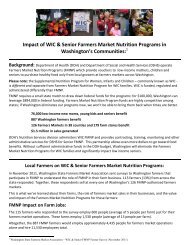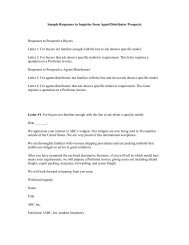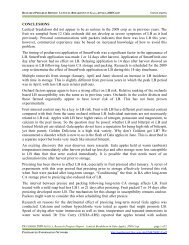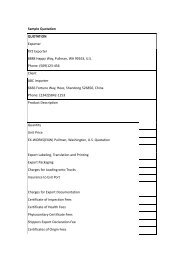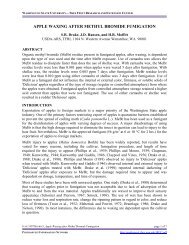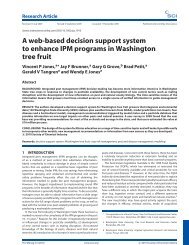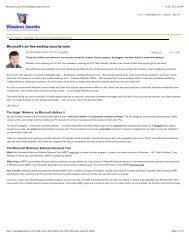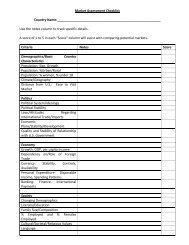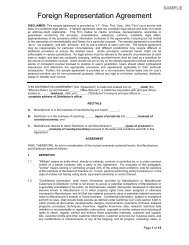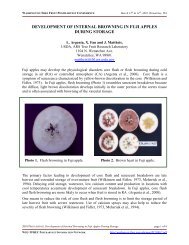Fruit Packing and Storage Loss Prevention Guidelines (2002)
Fruit Packing and Storage Loss Prevention Guidelines (2002)
Fruit Packing and Storage Loss Prevention Guidelines (2002)
You also want an ePaper? Increase the reach of your titles
YUMPU automatically turns print PDFs into web optimized ePapers that Google loves.
WASHINGTON STATE UNIVERSITY—TREE FRUIT RESEARCH AND EXTENSION CENTER<br />
FRUIT PACKING AND STORAGE LOSS PREVENTION GUIDELINES<br />
Prepared for Marsh Advantage <strong>and</strong> Wausau Insurance Company<br />
by Anne M. Swindeman, Apple Advice, Yakima, WA.<br />
INTRODUCTION<br />
Every year fruit losses occur at warehouses that could have been easily prevented had<br />
communications or quality control programs been better. The information contained in this<br />
manual was compiled from many industry <strong>and</strong> research sources to help storage operators prevent<br />
fruit storage <strong>and</strong> postharvest chemical injury losses <strong>and</strong> the resulting insurance claims.<br />
PREHARVEST CONSIDERATIONS<br />
Controlled Atmosphere Equipment <strong>and</strong> Room Preparation<br />
Each facility should have a lead storage operator who is properly trained <strong>and</strong> certified in<br />
refrigeration technology, preferably with a good working knowledge of the fruit industry. In<br />
addition, a maintenance contract should be in place with a reputable refrigeration service.<br />
All controlled atmosphere (CA) rooms should be leak tested by competent personnel every year<br />
prior to loading. All leaks should be repaired until the room is sufficiently tight. Floor bumpers<br />
should be installed if not already present. This is also a good time to disinfect walls, refresh<br />
floor striping, install <strong>and</strong> calibrate temperature probes <strong>and</strong> service refrigeration equipment.<br />
Analytical equipment should be calibrated <strong>and</strong> oxygen <strong>and</strong> carbon dioxide cells should be<br />
replaced by certified technicians. A working, calibrated portable analyzer should be on h<strong>and</strong> to<br />
serve as a back up to the main analyzer.<br />
Safety inspections of the facility should also be made. If corridors or mezzanine walks are<br />
present within CA facilities, sample tubing should be in place so oxygen <strong>and</strong> ammonia levels can<br />
be monitored to ensure worker safety at all times. Signs should be posted outside of all CA<br />
rooms clearly warning of the danger of low oxygen within the rooms. Compressor rooms should<br />
be posted with “Authorized Personnel” signs.<br />
All maintenance procedures should be recorded in a dedicated book. This book should be<br />
preserved for historical purposes.<br />
Marketing <strong>and</strong> Harvest Strategies<br />
Proper harvest maturity is absolutely critical for the successful storage of fruit. Since ideal<br />
harvest maturity is dependent on the intended destination of the fruit, marketing plans should be<br />
discussed in detail with the field staff during the preharvest season. These plans will determine<br />
the amount of fruit needed for each storage regime <strong>and</strong> marketing period throughout the year.<br />
The field staff should also be expected to communicate any delays or horticultural concerns as<br />
they occur since these may change the overall plan.<br />
Drench <strong>and</strong> other postharvest chemical applications should be outlined as well. Pears are<br />
extremely susceptible to scald, so the marketing plan should be designed to ensure that pears are<br />
treated with ethoxyquin very soon after harvest. If they are not to be drenched upon receiving,<br />
packing line time should be made available within a short time of harvest to prevent both scald<br />
<strong>and</strong> scuffing.<br />
DECEMBER <strong>2002</strong> ARTICLE, <strong>Fruit</strong> <strong>Packing</strong> <strong>and</strong> <strong>Storage</strong> <strong>Loss</strong> <strong>Prevention</strong> <strong>Guidelines</strong> page 1 of 9<br />
POSTHARVEST INFORMATION NETWORK<br />
http://postharvest.tfrec.wsu.edu/REP<strong>2002</strong>D.pdf
WASHINGTON STATE UNIVERSITY—TREE FRUIT RESEARCH AND EXTENSION CENTER<br />
Certain apple varieties such as Granny Smith should have an antioxidant treatment such as<br />
diphenylamine (DPA), regardless of storage regime. DPA is optional for short term Red<br />
Delicious, Gala, Fuji, <strong>and</strong> Braeburn since these varieties are not highly prone to storage scald;<br />
the latter two varieties may benefit from DPA if internal browning is a concern that growing<br />
season. These varieties may benefit from calcium (particularly when spring weather is cool <strong>and</strong><br />
calcium uptake is low) <strong>and</strong> fungicidal drenches regardless. This is the time to evaluate market<br />
dem<strong>and</strong>s <strong>and</strong> consult with growers if this is a grower option at your warehouse.<br />
MCP (SmartFresh, AgroFresh) is a newly available postharvest tool for apples. We may<br />
find that it will replace the need for DPA on certain varieties; however, there is a lot about this<br />
chemical that we do not yet know. It significantly reduces fruit respiration; therefore, it appears<br />
not to be a viable product for use on apples having watercore at harvest. Internal browning<br />
disorders may result if applied to watercored apples. Therefore, SmartFresh is not currently<br />
recommended for use on Fuji, Braeburn <strong>and</strong> late harvested Red Delicious with watercore. As<br />
with any chemical, always follow the label!<br />
Orchard Sampling<br />
A proper sampling program ensures that representative fruit is tested within each block. For<br />
determining fruit maturity, non-damaged fruit from average, as well as more advanced maturity<br />
should be the focus for testing since the primary goal is to prevent condition problems <strong>and</strong> other<br />
related disorders in storage. At least 10 fruit should be collected <strong>and</strong> tested from each sampling<br />
location within an orchard block. Locations to sample should include the earliest area of the<br />
orchard block, an average area, <strong>and</strong> the latest area of the block if at all possible. Undamaged<br />
fruit should be harvested from the south or west side of the tree <strong>and</strong> outer 12 inches of canopy.<br />
These will represent the most mature fruit of each location. Factors such as bloom date, soil type<br />
<strong>and</strong> tree vigor may be of help to the field staff or consultant in determining these areas.<br />
Preharvest maturity testing should begin in the orchard on a regular basis at least 2 to 3 weeks<br />
prior to anticipated harvest, depending on the commodity.<br />
Maturity Testing<br />
Pears are harvested pre-climacteric with respect to ethylene production, meaning they have not<br />
yet begun to ripen on the tree. Two highly informative articles written by Paul Chen <strong>and</strong> Diane<br />
Varga can be found at the end of this manual.<br />
Bartlett harvest is usually started when average firmness approaches 18 lb, depending on fruit<br />
size. Larger fruit will be generally less firm than smaller fruit at the same maturity level due to<br />
cell size differences. If ethylene testing is available, ideal maturity of Bartlett would correlate to<br />
3 to 5 days before onset of the ethylene climacteric. Properly harvested Bartletts should store<br />
well in CA for up to 3 months <strong>and</strong> retain normal ripening capacity.<br />
Anjou pears are harvested typically 2 or more weeks preclimacteric, at approximately 135 to<br />
147 days, or when firmness levels approach 15 lb. At this time, the lenticels begin to cork <strong>and</strong><br />
the flesh color between the lenticels lightens, wax develops <strong>and</strong> the fruit becomes rounder as it<br />
fills out. Soluble solids measurements <strong>and</strong> starch tests are also of additional value in determining<br />
Anjou maturity. Due to the number of postharvest maladies affecting Anjou pears stored long<br />
term, most rooms should be targeted for opening within six months of harvest.<br />
DECEMBER <strong>2002</strong> ARTICLE, <strong>Fruit</strong> <strong>Packing</strong> <strong>and</strong> <strong>Storage</strong> <strong>Loss</strong> <strong>Prevention</strong> <strong>Guidelines</strong> page 2 of 9<br />
POSTHARVEST INFORMATION NETWORK<br />
http://postharvest.tfrec.wsu.edu/REP<strong>2002</strong>D.pdf
WASHINGTON STATE UNIVERSITY—TREE FRUIT RESEARCH AND EXTENSION CENTER<br />
Harvesting too early results in greater susceptibility to storage scald, friction marking (scuffing),<br />
<strong>and</strong> inability to ripen properly. Harvest for shorter term storage can generally be delayed until<br />
firmness is approaching 13 lb. Harvesting later may result in yellower fruit with a reduced<br />
storage life, <strong>and</strong> an increased susceptibility to carbon dioxide injury. Firmness measurements on<br />
pears are most representative if done in the morning hours.<br />
Apples are optimally harvested at a mature, yet pre-climacteric state with respect to ethylene<br />
production for long term CA storage, <strong>and</strong> post-climacteric for the shorter term CA storage<br />
regimes. At a minimum, fruit firmness <strong>and</strong> starch iodine tests should be done with results<br />
recorded on each sample weekly by experienced personnel.<br />
Ethylene monitoring is recommended on apples destined for long-term CA storage, since<br />
successful storage is highly dependent on harvesting fruit prior to the onset of the ethylene<br />
climacteric. This onset of ethylene production precedes significant firmness <strong>and</strong> starch changes.<br />
The optimum harvest window for truly long term CA storage may be as short at 3 days in some<br />
orchard blocks.<br />
Firmness varies from grower to grower <strong>and</strong> variety to variety. Orchard nutrition programs <strong>and</strong><br />
fruit size play significant roles in firmness as measured in preclimacteric fruit. Therefore, some<br />
fruit may be mature at 18 lb, whereas other fruit may not be mature until it is 13 lb. Most export<br />
<strong>and</strong> many domestic buyers are currently dem<strong>and</strong>ing 14 lb <strong>and</strong> higher Red Delicious, <strong>and</strong> there<br />
are minimum firmness requirements in place for several varieties in the Washington apple<br />
industry.<br />
Starch charts are available for each major apple variety <strong>and</strong> there are recommendations<br />
available from extension specialists regarding trends. However, just as firmness can vary with<br />
growing conditions, so can starch measurements. Starch is converted to sugar as fruit respire.<br />
<strong>Fruit</strong> with a high nitrogen to calcium ratio respire more rapidly than nutritionally balanced fruit.<br />
<strong>Fruit</strong> grown in hot seasons will respire more rapidly than in cool seasons. <strong>Fruit</strong> treated with<br />
ReTain (TM, Valent BioSciences), a growth regulator that delays ripening processes for up to 2<br />
to 3 weeks, will tend to have higher starch ratings than non-treated fruit at full maturity (ethylene<br />
onset) due to the fact that respiratory processes continue during this time.<br />
Soluble solids (sugars) should be used to a minor degree, if only to reference flavor<br />
development. Nutrition programs, crop load <strong>and</strong> maturity all influence soluble solids, so there<br />
are no absolute values available to use in maturity determinations.<br />
It is important to note that even the best controlled atmosphere technology will not reverse the<br />
ripening processes if fruit is harvested too late or mish<strong>and</strong>led after harvest; fruit harvested too<br />
late will result in condition problems, increased potential for storage rots <strong>and</strong> other internal<br />
disorders. Harvesting too early, on the other h<strong>and</strong>, can lead to the development of superficial<br />
storage scald, bitter pit <strong>and</strong>/or poor flavor development.<br />
HARVEST AND STORAGE<br />
Warehouse Receiving, Sampling <strong>and</strong> Testing<br />
<strong>Fruit</strong> should be delivered to the warehouse, sampled for quality control purposes, drenched (if<br />
applicable), <strong>and</strong> put under refrigeration as quickly as possible after harvest. This should be done<br />
within a day of harvest since ripening processes occur at a much higher rate once fruit is<br />
detached from the tree. If for some reason the warehouse cannot receive the fruit quickly, it is<br />
DECEMBER <strong>2002</strong> ARTICLE, <strong>Fruit</strong> <strong>Packing</strong> <strong>and</strong> <strong>Storage</strong> <strong>Loss</strong> <strong>Prevention</strong> <strong>Guidelines</strong> page 3 of 9<br />
POSTHARVEST INFORMATION NETWORK<br />
http://postharvest.tfrec.wsu.edu/REP<strong>2002</strong>D.pdf
WASHINGTON STATE UNIVERSITY—TREE FRUIT RESEARCH AND EXTENSION CENTER<br />
much better to delay harvest. The possible exceptions to this rule are Braeburn <strong>and</strong> Fuji (as long<br />
as the weather is cooperative), since these varieties seem to benefit from added ventilation <strong>and</strong><br />
slower cooling.<br />
Samples should be pulled from each load of fruit upon delivery to the warehouse, except in the<br />
case of very large lots in which case sampling every second or third load may suffice. These<br />
samples should then be tested for firmness, starch <strong>and</strong> soluble solids <strong>and</strong> all data should be<br />
recorded for future reference. The actual number of fruit tested should be representative of the<br />
quantities delivered. For a full load of 64 bins, it is recommended that at least 15 to 20<br />
undamaged apples of a representative size range be selected <strong>and</strong> tested from the load. At the<br />
same time as receiving samples are pulled, samples may also be conveniently pulled which will<br />
later serve as “window” samples in the CA room (see “Pulling Window Samples” below).<br />
Pulling Window Samples<br />
Enough fruit should be pulled from loads being received so that at least 10 fruit (preferably 15 to<br />
20) from each lot can be tested each month from the CA room. Some warehouses place these<br />
samples into boxes designated for each lot. All samples are kept cold during the receiving<br />
process, <strong>and</strong> upon filling the CA room, monthly samples may either be pre-bagged at r<strong>and</strong>om<br />
from the composite sample or the entire box may be placed at the CA room window. This will<br />
result in a more representative sample of fruit across the room than bagging samples from<br />
particular loads or harvest dates.<br />
Be aware that using poly bags for samples can create false atmospheres (higher carbon dioxide,<br />
etc.) so samples may not be truly representative of the fruit actually stored in the bins if<br />
temperatures are allowed to fluctuate. Samples must be h<strong>and</strong>led similar to the incoming bins in<br />
order to be truly representative.<br />
Drenching<br />
Always follow label directions! Do not try to stretch drench chemicals as contamination with<br />
spores <strong>and</strong> debris can cause further fruit damage. Have a testing program in place to monitor<br />
chemical concentrations accurately on a regular basis; some chemical dealers also sample fruit at<br />
regular intervals for laboratory testing.<br />
Ethoxyquin should be applied to Anjou pears either as a postharvest drench <strong>and</strong>/or at packing,<br />
depending on storage regime <strong>and</strong> fruit maturity. Split applications are permissible, as long as the<br />
total amount does not exceed the current label. Regardless of the method of application, it<br />
should be noted that ethoxyquin is most effective as an antioxidant if applied no later than<br />
one week after harvest.<br />
In general, apples destined for CA storage for over 3 months should be drenched with DPA <strong>and</strong><br />
fungicide (usually TBZ), unless it is organic. Calcium drenches are recommended in certain<br />
varieties such as Jonagold <strong>and</strong> Golden Delicious, both prone to bitter pit. In hot growing years<br />
<strong>and</strong> years with cool springs, calcium drenches can significantly increase fruit calcium levels <strong>and</strong><br />
help prevent storage disorders from occurring.<br />
<strong>Storage</strong> Compatibility of Varieties<br />
<strong>Fruit</strong> of the same variety or of compatible varieties should be stored together whenever possible,<br />
with the exception being for short term rooms. Golden Delicious <strong>and</strong> Jonagold apples are high<br />
ethylene producers in CA, often producing values as high as 1,500 to 2,000 ppm in static rooms<br />
DECEMBER <strong>2002</strong> ARTICLE, <strong>Fruit</strong> <strong>Packing</strong> <strong>and</strong> <strong>Storage</strong> <strong>Loss</strong> <strong>Prevention</strong> <strong>Guidelines</strong> page 4 of 9<br />
POSTHARVEST INFORMATION NETWORK<br />
http://postharvest.tfrec.wsu.edu/REP<strong>2002</strong>D.pdf
WASHINGTON STATE UNIVERSITY—TREE FRUIT RESEARCH AND EXTENSION CENTER<br />
(rooms using lime). Red Delicious, Rome, Braeburn, Granny Smith <strong>and</strong> Pink Lady® br<strong>and</strong><br />
apples are moderate ethylene producers, generally producing in the 200 to 500 ppm range. Gala<br />
ethylene production tends to slow down once under CA, <strong>and</strong> Fujis tend to be low producers<br />
throughout; these varieties generally test below 200 ppm. Nitrogen purged <strong>and</strong> carbon scrubbed<br />
(dynamic CA) rooms generally have only ~10% of the ethylene levels as lime (static) rooms.<br />
Anjou pears are very low producers of ethylene <strong>and</strong> are extremely sensitive to ethylene. Bartlett<br />
<strong>and</strong> Bosc will produce rather high levels of ethylene once ripening begins. Because of these<br />
differences, all rooms should be isolated by valves as soon as possible after pulldown to<br />
prevent gas mixing (including ethylene) between rooms.<br />
With the exception of Braeburn, Granny Smith, Fuji <strong>and</strong> Pink Lady® br<strong>and</strong> rooms (see Table 1),<br />
CA rooms should be filled <strong>and</strong> sealed within 3 to 7 days of harvest. Oxygen pulldown in apple<br />
rooms should commence as soon as a fruit temperature of 50 ºF or lower is reached. Delays in<br />
oxygen pulldown of 2 weeks or longer are not acceptable for most varieties.<br />
Table 1. CA storage recommendations.<br />
Variety<br />
Anjou pears<br />
(long term)<br />
Anjou pears<br />
(short term)<br />
Gala<br />
Antioxidant<br />
concentration<br />
Ethoxyquin, up<br />
to 2700 ppm<br />
Ethoxyquin in<br />
wraps<br />
DPA, 1000 ppm<br />
optional<br />
Cooling<br />
rate*<br />
Temp.<br />
(ºF)<br />
Oxygen<br />
(%)<br />
CO 2<br />
(%)<br />
O 2<br />
pulldown<br />
rate*<br />
Rapid 31.5 to 32 ºF 1.5 to 2.0% < 0.5% Rapid<br />
Rapid 31.5 to 32 ºF<br />
0.5% 1 st month<br />
1.0% 2 nd month<br />
then to 1.5%<br />
< 0.5% Rapid<br />
Rapid 33 to 34 ºF 1.0 to 1.5% < 2.5% Rapid<br />
Red Delicious<br />
(long term)<br />
DPA, 2000 ppm Rapid 32 ºF 1.2 to 1.5% < 2.5% Rapid<br />
Red Delicious<br />
(watercore)<br />
DPA, 2000 ppm Rapid 32 ºF 2.0 to 2.5% < 2.5% Moderate<br />
Golden<br />
Delicious<br />
Optional Rapid 33 to 34 ºF 1.2 to 1.5% < 2.5% Rapid<br />
Jonagold Optional Rapid 33 to 34 ºF 1.5% < 2.5% Rapid<br />
Granny Smith DPA, 2000 ppm Rapid 34 ºF 1.5% < 1.0% Slow<br />
Braeburn<br />
DPA, 1000 ppm<br />
optional<br />
Stepwise 38/36/34 ºF 1.5 to 2.5%** < 1.0% Slow<br />
Fuji<br />
DPA, 1000 ppm<br />
optional<br />
Stepwise 38/36/34 ºF 1.5 to 2.5%** < 1.0% Slow<br />
Pink Lady®<br />
br<strong>and</strong><br />
DPA, 1000 ppm Slow 33 to 34 ºF 1.8 to 2.0% < 1.0% Slow<br />
* Cooling <strong>and</strong> O 2 pulldown rates:<br />
Rapid = within 3 days<br />
Slow = 5 to 7 days<br />
Stepwise = 36 to 38 ºF during loading, 36 ºF at sealing, 34 ºF after 2 to 3 weeks of CA establishment<br />
** Watercored fruit should be stored at elevated oxygen levels (2.0 to 2.5%) to prevent anaerobiosis <strong>and</strong><br />
internal breakdown.<br />
(from Apple Advice, revised <strong>2002</strong>)<br />
DECEMBER <strong>2002</strong> ARTICLE, <strong>Fruit</strong> <strong>Packing</strong> <strong>and</strong> <strong>Storage</strong> <strong>Loss</strong> <strong>Prevention</strong> <strong>Guidelines</strong> page 5 of 9<br />
POSTHARVEST INFORMATION NETWORK<br />
http://postharvest.tfrec.wsu.edu/REP<strong>2002</strong>D.pdf
WASHINGTON STATE UNIVERSITY—TREE FRUIT RESEARCH AND EXTENSION CENTER<br />
CA Room Loading, Sealing <strong>and</strong> Pulldown<br />
CA rooms should be precooled to the desired setpoint before product loading begins. The<br />
porthole should be cracked during the precooling process to alleviate any sudden pressure<br />
changes in the room which could result in blown seals <strong>and</strong>/or structural damage to the CA room.<br />
Refrigeration equipment problems, if present, will often be revealed at this point.<br />
All personnel involved in loading CA rooms should be instructed on proper loading techniques<br />
as well as forklift safety. Your warehouse should have a forklift safety program already in place.<br />
To ensure proper loading, floors should be lined out (striped) to make this process clear. Floor<br />
bumpers not only help with bin to wall spacing requirements for optimal air flow patterns, but<br />
also help reduce the incidence of wall damage during loading. Forklift drivers should underst<strong>and</strong><br />
the importance of reporting any possible damage that has occurred during the loading process.<br />
Only bins of the same size <strong>and</strong> type should be used to avoid air circulation problems which may<br />
result in fruit losses. If bin types must be mixed, a gap should be left between the types so that<br />
air flow can be redirected into the bin runners appropriately. Be sure to leave a free space of 18<br />
to 24 inches at the front <strong>and</strong> back walls.<br />
In the case of static CA rooms, drivers should be instructed as to amount <strong>and</strong> placement of<br />
pallets of lime within the room. The amount of lime used should be sufficient to last the entire<br />
anticipated storage period; typically for mid to late term storage, 2 lb per box should be allotted.<br />
More lime should be used if growing conditions were unfavorable (cool springs, excessively hot<br />
summer/fall weather). If fruit nitrogen to calcium levels are out of balance (too much nitrogen),<br />
lime needs may be higher since respiration rates tend to be higher in this type of fruit. Lime is<br />
required if there is no other means available to scrub (remove) respiratory carbon dioxide.<br />
Pears should be moved from the orchard to the storage within 24 hours after harvest. Rapid<br />
removal of field heat is essential for successful storage of pears. Pears should be completely<br />
precooled prior to oxygen pulldown. <strong>Fruit</strong> should be cooled to 30 ºF within 5 days of harvest.<br />
CA conditions should be introduced as soon as possible as any delay following harvest reduces<br />
postharvest life <strong>and</strong> fruit quality. Low oxygen (0.5% oxygen) CA storage <strong>and</strong> dynamic (purge)<br />
CA systems are proving successful in scald prevention. See Chen articles (in Reference section)<br />
for further information.<br />
Monitoring CA Rooms<br />
Analytical equipment must be calibrated by trained personnel at the beginning of the storage<br />
season <strong>and</strong> at recommended intervals (more frequently if at all possible) with span gas. Many<br />
new analyzers recalibrate themselves continually. Alarm systems should be programmed to call<br />
several different persons in the case of emergency. Ammonia sensing cards are also available to<br />
place at the portholes for a quick reference <strong>and</strong> double check.<br />
Even if your facility is fully computerized, it is a good practice to manually check each room<br />
weekly with a back up analyzer at the room portholes. This will help prevent storage losses due<br />
to failing oxygen <strong>and</strong> carbon dioxide sensors, improperly calibrated analyzers, power outages<br />
that have inadvertently reset parameters, sample lines which have been damaged, etc. All<br />
monitoring must be done by trained personnel to ensure accuracy of calibration <strong>and</strong> best use of<br />
information. Any discrepancies in data between monitoring equipment should be immediately<br />
noted <strong>and</strong> investigated. If ammonia sensing cards are used by the facility, this is a good time to<br />
check them as well.<br />
DECEMBER <strong>2002</strong> ARTICLE, <strong>Fruit</strong> <strong>Packing</strong> <strong>and</strong> <strong>Storage</strong> <strong>Loss</strong> <strong>Prevention</strong> <strong>Guidelines</strong> page 6 of 9<br />
POSTHARVEST INFORMATION NETWORK<br />
http://postharvest.tfrec.wsu.edu/REP<strong>2002</strong>D.pdf
WASHINGTON STATE UNIVERSITY—TREE FRUIT RESEARCH AND EXTENSION CENTER<br />
CA rooms should be analyzed for temperature (preferably using multiple probes located in the<br />
rooms per the Mexico program), oxygen <strong>and</strong> carbon dioxide levels twice daily. Many<br />
computerized facilities are analyzing these parameters hourly, as well as monitoring for<br />
ammonia throughout the day.<br />
There are times when the calculated amount of lime “runs out” before the operator is ready to<br />
open the room. In these cases, it has been found that raising the oxygen level to 1.0% above the<br />
carbon dioxide level will help prevent internal fruit damage.<br />
Quality Control of CA Rooms<br />
It is recommended to check fruit quality on a regular basis (usually monthly) within the CA<br />
rooms. Without these checks, it is nearly impossible to distinguish some chemical injuries from<br />
other disorders as time goes on. Knowing when the disorder first appears is often essential if the<br />
cause of the disorder is to be determined.<br />
Most facilities begin testing window samples (samples pulled upon receiving from each grower<br />
lot) in early December. Window samples are most helpful in assessing storage disorders such as<br />
scald <strong>and</strong> internal browning if they are kept at ambient oxygen for at least one day prior to<br />
pressure testing. After making an initial visual assessment of the fruit, firmness measurements<br />
should be recorded, after which fruit should be cut to view internally <strong>and</strong> “feel” for condition<br />
weaknesses near the core area. Oftentimes, fruit firmness measurements (taken from the outer<br />
surface of the fruit) are misleading since some fruit will soften internally first; this is why a<br />
follow up “feel” is helpful. Whenever disorders are noted, either internally or externally, an<br />
investigation should be made as to the cause. More samples may need to be tested directly from<br />
bins in the room in order to determine if the damage is to a single grower lot or multiple lots<br />
within, <strong>and</strong> also if it is progressive. When looking at firmness measurements, both the average<br />
<strong>and</strong> range of values (st<strong>and</strong>ard deviation is helpful) should be taken into consideration each<br />
month. It is also helpful to record fruit size, color <strong>and</strong> “grade” of fruit within samples when<br />
recording data. Only packable fruit should be tested for firmness; culls should be noted but<br />
discarded.<br />
Monthly ethylene monitoring of the CA atmosphere has also proven valuable in determining<br />
fruit condition. Sudden or significant increases in ethylene can alert operators to distressed fruit<br />
up to 2 months prior to actually measuring the increased rate of fruit softening. This flexibility<br />
allows a warehouse to open the CA earlier if possible <strong>and</strong> market it before condition is<br />
compromised.<br />
Opening CA Rooms<br />
Safety procedures should be in place regarding open CA rooms. Team approaches to opening<br />
rooms are best, in case of medical emergency. Extreme caution must be taken to prevent any<br />
human or animal from entering the CA room before it is adequately aired. Some facilities open<br />
the sampling door <strong>and</strong> place a cage over this door to hasten airing. Others stack empty bins<br />
closely in front of the door. High volume fans may help reduce the amount of time to air up a<br />
room.<br />
Bruise-sensitive varieties such as Golden Delicious <strong>and</strong> Granny Smith often benefit from airing<br />
prior to packing. Many warehouses will open Golden rooms <strong>and</strong> allow them to sit for<br />
DECEMBER <strong>2002</strong> ARTICLE, <strong>Fruit</strong> <strong>Packing</strong> <strong>and</strong> <strong>Storage</strong> <strong>Loss</strong> <strong>Prevention</strong> <strong>Guidelines</strong> page 7 of 9<br />
POSTHARVEST INFORMATION NETWORK<br />
http://postharvest.tfrec.wsu.edu/REP<strong>2002</strong>D.pdf
WASHINGTON STATE UNIVERSITY—TREE FRUIT RESEARCH AND EXTENSION CENTER<br />
approximately 3 days at slightly elevated storage temperatures (~40 ºF). This allows for a slight<br />
dehydration of the skin which seems to help reduce bruising.<br />
Hardier varieties can be unloaded from the storage as soon as the oxygen levels in the room have<br />
reached ambient conditions.<br />
PACKING<br />
<strong>Packing</strong> <strong>and</strong> Packed <strong>Fruit</strong> <strong>Storage</strong><br />
Less friction marking occurs on pears that are picked at the correct maturity (i.e., not immature)<br />
<strong>and</strong> packed within 3 to 4 weeks of harvest. When pears are packed directly from cold storage, do<br />
not warm prior to packing. Avoid unnecessary drying of pears as water lubricates the fruit on the<br />
packing line. Reducing the packing line speed is also effective in reducing injury.<br />
Chemical injury is another major problem with pears. <strong>Fruit</strong> must be rinsed thoroughly after<br />
leaving the dump tank as the salts in the flotation solution can cause irreparable damage to the<br />
skin. <strong>Fruit</strong> should also be dry by the time they are wrapped in copper/ethoxyquin impregnated<br />
wraps to avoid marking.<br />
Before each packing shift begins, dump tank water temperature as well as chlorine <strong>and</strong> fungicide<br />
concentrations (<strong>and</strong> pear float solutions) should be checked <strong>and</strong> adjustments made if needed.<br />
Make sure the wax type is correct for the variety or order being packed (for instance, Braeburn<br />
apples do not tolerate shellac waxes well). A daily log should be kept regarding all levels of<br />
chemicals <strong>and</strong> wax types used. Adhere to all state <strong>and</strong> federal laws.<br />
Palletized fruit should be returned to refrigeration as soon after packing as possible. Refrigerated<br />
rooms should be loaded to enhance cooling of the packaged fruit. Pears <strong>and</strong> other ethylene<br />
sensitive commodities should not be stored in the same rooms as apples <strong>and</strong> other high ethylene<br />
producers unless pre-ripening is desired!<br />
Packed inventory should be turned as quickly as possible, <strong>and</strong> a quality control person should<br />
make regular checks on packed inventory for condition changes.<br />
EMERGENCY PLAN<br />
A written emergency plan should be in effect for every warehouse in the event of injury, fires,<br />
chemical spills, ammonia leaks, etc. All employees should be provided with training to ensure<br />
that they underst<strong>and</strong> procedures.<br />
DECEMBER <strong>2002</strong> ARTICLE, <strong>Fruit</strong> <strong>Packing</strong> <strong>and</strong> <strong>Storage</strong> <strong>Loss</strong> <strong>Prevention</strong> <strong>Guidelines</strong> page 8 of 9<br />
POSTHARVEST INFORMATION NETWORK<br />
http://postharvest.tfrec.wsu.edu/REP<strong>2002</strong>D.pdf
WASHINGTON STATE UNIVERSITY—TREE FRUIT RESEARCH AND EXTENSION CENTER<br />
SUGGESTED READING/LIBRARY REFERENCE MATERIALS<br />
Postharvest disorders of apples <strong>and</strong> pears. Agriculture Canada Publication 1737/E, 1994.<br />
Market Diseases of Apples, Pears, <strong>and</strong> Quinces. Agriculture H<strong>and</strong>book No. 376, USDA, 1971.<br />
http://postharvest.tfrec.wsu.edu/market_diseases.html<br />
Chen, Paul M. <strong>and</strong> Diane M. Varga. <strong>Storage</strong> Challenges with Winter Pears. In: Washington<br />
Tree <strong>Fruit</strong> Postharvest Conference Proceedings, 1996. p. 79-83.<br />
http://postharvest.tfrec.wsu.edu/PC96A.pdf<br />
Chen, Paul M. <strong>and</strong> Diane M. Varga. CA Regimes for Control of Superficial Scald of d’Anjou<br />
Pears. In: Washington Tree <strong>Fruit</strong> Postharvest Conference Proceedings, 1997. p. 17-26.<br />
http://postharvest.tfrec.wsu.edu/pgDisplay.php?article=PC97A<br />
Kupferman, Dr. Eugene. Observations on Harvest Maturity <strong>and</strong> <strong>Storage</strong> of Apples <strong>and</strong> Pears.<br />
http://postharvest.tfrec.wsu.edu/EMK2000A.pdf<br />
DECEMBER <strong>2002</strong> ARTICLE, <strong>Fruit</strong> <strong>Packing</strong> <strong>and</strong> <strong>Storage</strong> <strong>Loss</strong> <strong>Prevention</strong> <strong>Guidelines</strong> page 9 of 9<br />
POSTHARVEST INFORMATION NETWORK<br />
http://postharvest.tfrec.wsu.edu/REP<strong>2002</strong>D.pdf




